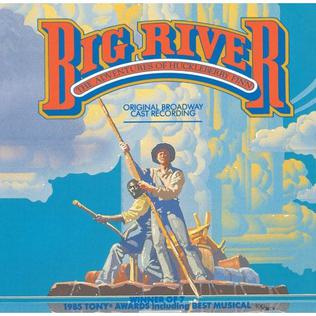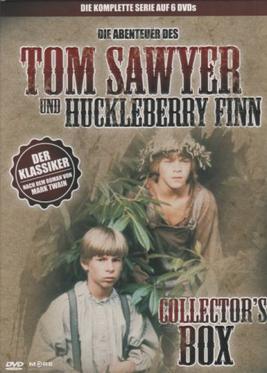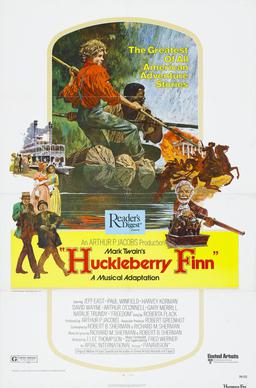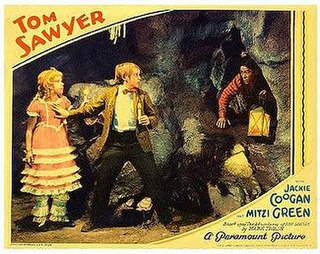
Adventures of Huckleberry Finn is a novel by American author Mark Twain, which was first published in the United Kingdom in December 1884 and in the United States in February 1885.

Big River: The Adventures of Huckleberry Finn is a musical with music and lyrics by Roger Miller, and a book by William Hauptman.

Tom Sawyer Abroad is a novel by Mark Twain published in 1894. It features Tom Sawyer and Huckleberry Finn in a parody of adventure stories like those of Jules Verne.

Huckleberry Finn and His Friends is a 1979 television series documenting the exploits of Huckleberry Finn and Tom Sawyer, based on the novels The Adventures of Tom Sawyer (1876) and Adventures of Huckleberry Finn (1884) by American writer Mark Twain. The series consists of 26 episodes and was a Canadian/West German international co-production.

The Adventures of Huck Finn is a 1993 American comedy drama adventure film written and directed by Stephen Sommers, and starring Elijah Wood, Courtney B. Vance, Jason Robards and Robbie Coltrane. Distributed by Walt Disney Studios Motion Pictures and Buena Vista Pictures, it is based on Mark Twain's 1884 novel Adventures of Huckleberry Finn and focuses on at least three-quarters of the book.

The Mark Twain Boyhood Home & Museum is located on 206-208 Hill Street, Hannibal, Missouri, on the west bank of the Mississippi River in the United States. It was the home of Samuel Langhorne Clemens, better known as author Mark Twain, from 1844 to 1853. Clemens found the inspiration for many of his stories, including the white picket fence, while living here. It has been open to the public as a museum since 1912, and was designated a National Historic Landmark on December 29, 1962. It is located in the Mark Twain Historic District.

Huckleberry Finn is a 1974 musical film version of Mark Twain's 1884 novel The Adventures of Huckleberry Finn.
Mark Twain: The Musical is a stage musical biography of Mark Twain that had a ten-year summertime run in Elmira, NY and Hartford, CT (1987–1995) and was telecast on a number of public television stations. An original cast CD was released by Premier Recordings in 1988, and LML Music in 2009 issued a newly mastered and complete version of the score. Video and DVD versions of the show are currently in release.

The Adventures of Huckleberry Finn is a 1939 Metro-Goldwyn-Mayer film adaptation of Mark Twain's 1884 novel of the same name, starring Mickey Rooney in the title role. The supporting cast features Walter Connolly, William Frawley and Rex Ingram. It was remade by MGM in 1960. A musical version was released in 1974.

Huckleberry no Bōken (ハックルベリィの冒険) is a Japanese anime television series based on the 1884 novel Adventures of Huckleberry Finn by Mark Twain that aired on the Fuji Television network every Friday evening from January 2, 1976 to June 25 of the same year, for a total of 26 episodes. It is the first of two Huckleberry Finn anime. A second Huck Finn television series was made in 1994, Huckleberry Finn Monogatari.

Huckleberry "Huck" Finn is a fictional character created by Mark Twain who first appeared in the book The Adventures of Tom Sawyer (1876) and is the protagonist and narrator of its sequel, Adventures of Huckleberry Finn (1884). He is 12 to 13 years old during the former and a year older at the time of the latter. Huck also narrates Tom Sawyer Abroad and Tom Sawyer, Detective, two shorter sequels to the first two books.

Tom Sawyer is a 1930 American pre-Code comedy-drama film directed by John Cromwell and starring Jackie Coogan. The screenplay by Grover Jones, William Slavens McNutt, and Sam Mintz is based on the 1876 novel The Adventures of Tom Sawyer by Mark Twain.

The Adventures of Huckleberry Finn is a 1960 American drama film directed by Michael Curtiz. Based on the 1884 novel of the same name by Mark Twain, it was the third sound film version of the story and the second filmed by Metro-Goldwyn-Mayer. The film was the first adaptation of Huckleberry Finn to be filmed in CinemaScope and Technicolor. It stars Eddie Hodges as Huck and former boxer Archie Moore as the runaway slave Jim. Tony Randall also appeared in the film, and Buster Keaton had a bit role in what proved to be his final film for Metro-Goldwyn-Mayer, his former studio. Neville Brand portrayed Pap Finn, Huck's alcoholic father.
Alan Gribben is a professor emeritus of English at Auburn University at Montgomery in Alabama and a Mark Twain scholar. He was distinguished research professor from 1998 to 2001 and the Dr. Guinevera A. Nance Alumni Professor from 2006 to 2009. He engendered widespread controversy in 2011 when he announced the publication of expurgated versions of Twain's works.

Huckleberry Finn is a 1931 American pre-Code adventure comedy film directed by Norman Taurog, and written by Grover Jones and William Slavens McNutt, based on Mark Twain's 1884 novel The Adventures of Huckleberry Finn. It stars Jackie Coogan as Tom Sawyer, Mitzi Green as Becky Thatcher, Junior Durkin as Huckleberry Finn, and Jackie Searl as Sid Sawyer.

Huckleberry Finn is a surviving American silent dramatic rural film from 1920, based on Mark Twain's 1884 classic Adventures of Huckleberry Finn. It was produced by Famous Players–Lasky and distributed through Paramount Pictures. William Desmond Taylor directed Huckleberry Finn, as he had the 1917 film version of Tom Sawyer, using a scenario written by Julia Crawford Ivers, who also had been the writer for Tom Sawyer.

The Adventures of Tom Sawyer is an 1876 novel by Mark Twain about a boy, Tom Sawyer, growing up along the Mississippi River. It is set in the 1840s in the town of St. Petersburg, which is based on Hannibal, Missouri, where Twain lived as a boy. In the novel, Sawyer has several adventures, often with his friend Huckleberry Finn. Originally a commercial failure, the book ended up being the best-selling of Twain's works during his lifetime. Though overshadowed by its 1884 sequel, Adventures of Huckleberry Finn, the book is considered by many to be a masterpiece of American literature. It is alleged by Mark Twain to be one of the first novels to be written on a typewriter.
Rascals and Robbers: The Secret Adventures of Tom Sawyer and Huckleberry Finn is a 1982 American made-for-television adventure film originally broadcast February 27, 1982 on CBS as the TV Movie of the Week. CBS financed the film with a $2.2 million budget and the working title was The Further Adventures of Tom Sawyer and Huckleberry Finn. The film was shot on location in Natchez, Mississippi in the fall of 1981 where the filmmakers added dirt to the street of the historic town. The movie features early roles for Cynthia Nixon and Anthony Michael Hall. It was the first major role for then-child actor and future award-winning filmmaker Patrick Creadon, who starred as Tom. The teleplay was written by Carlos Davis and David Taylor. It was directed by Dick Lowry and produced by his brother Hunt Lowry.
"The Adventures of Huckleberry Finn" is a 1955 CBS TV film adaptation of Mark Twain's 1884 novel of the same name, starring Charles Taylor in the title role. It was directed by Herbert B. Swope Jr. It aired on September 1, 1955 as the Season 2 premiere of the anthology program Climax!.















